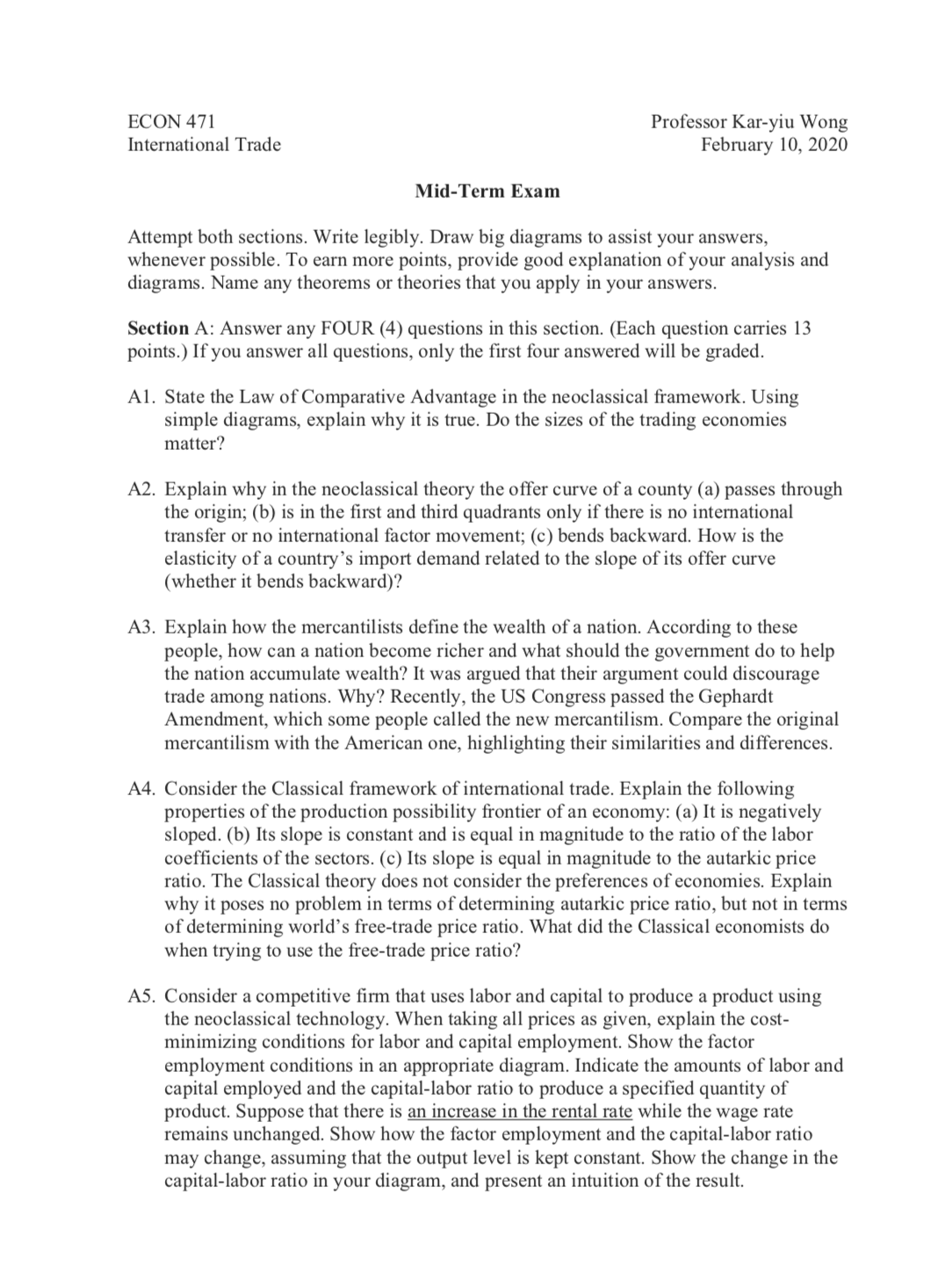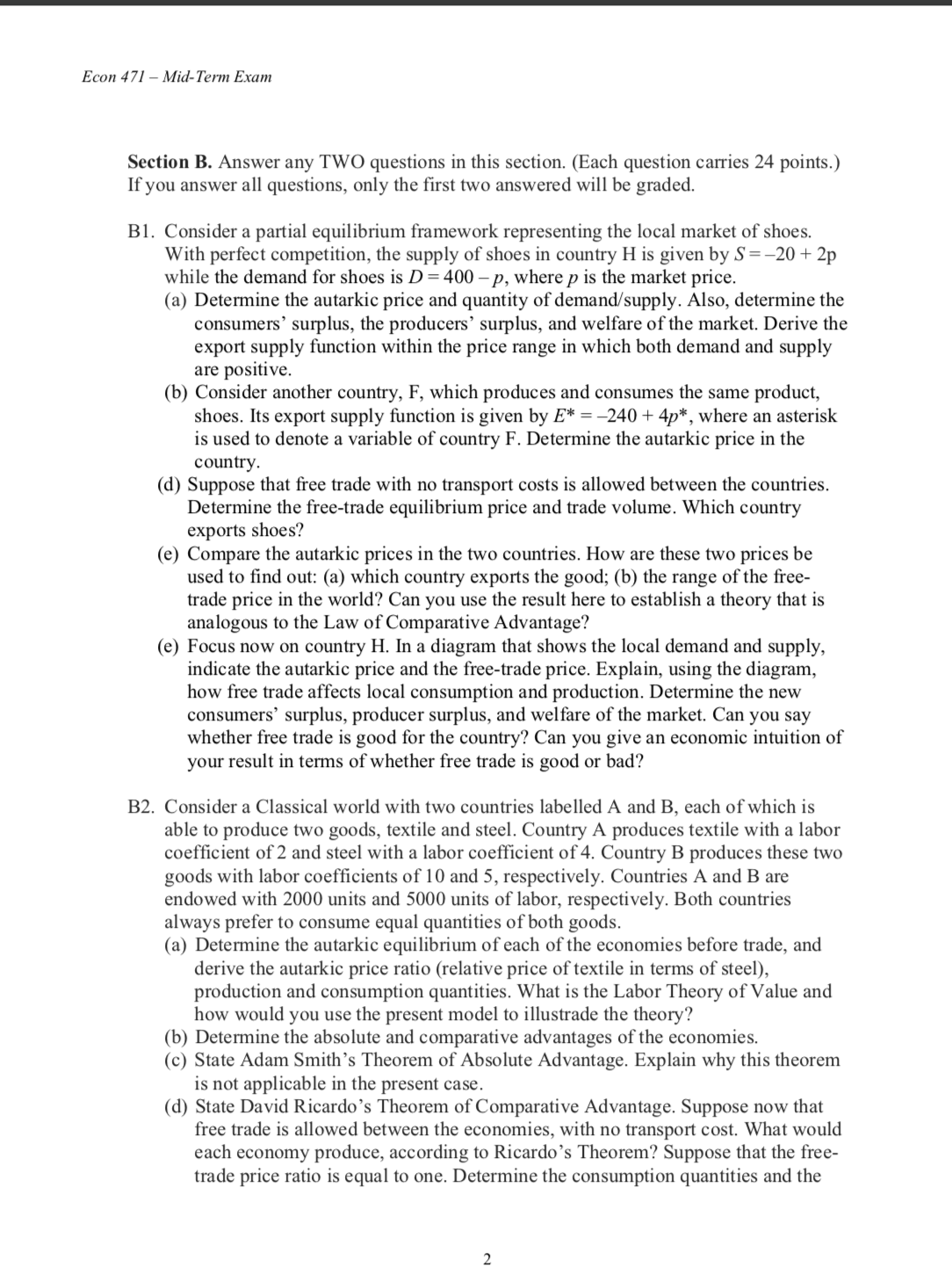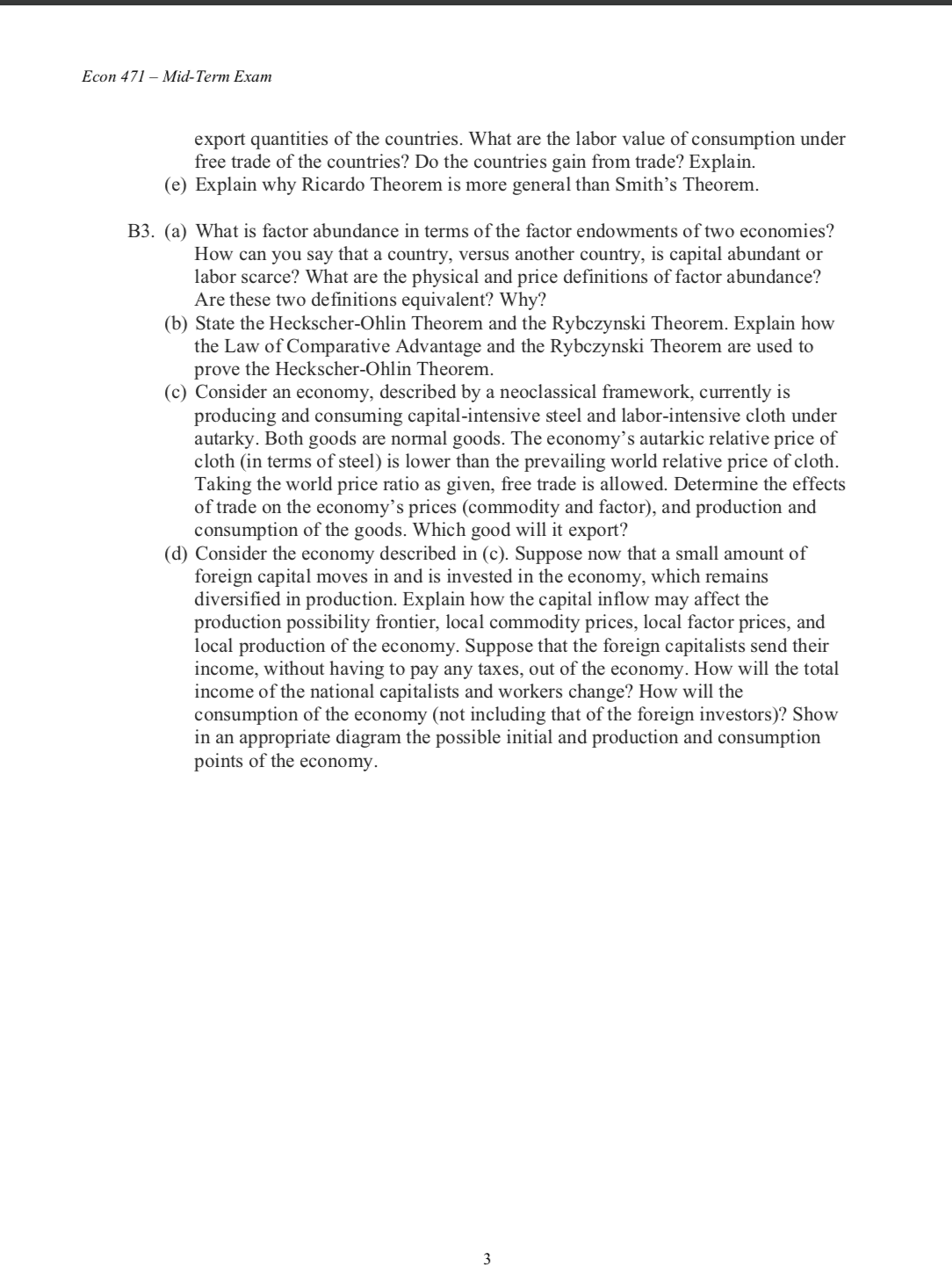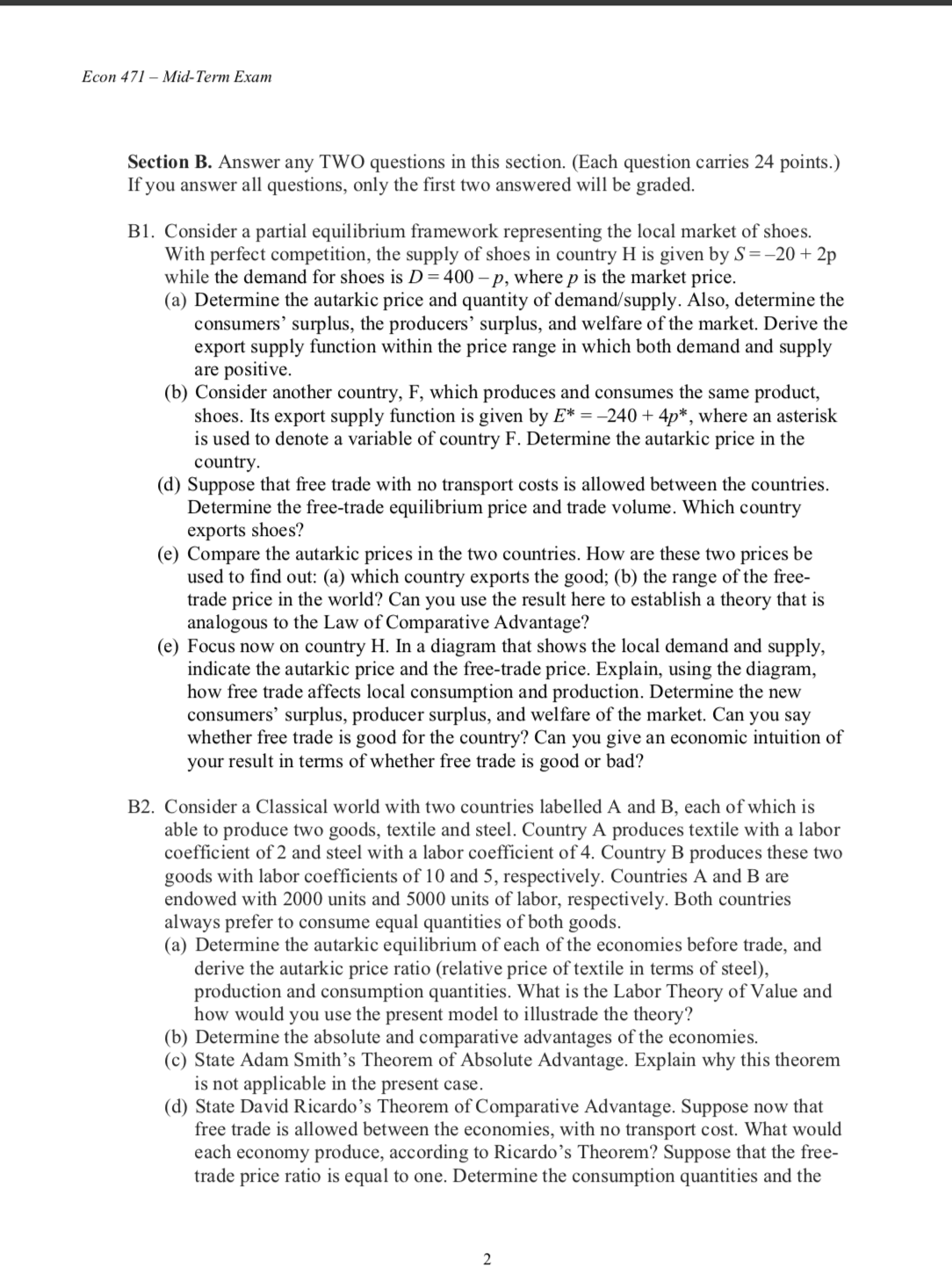
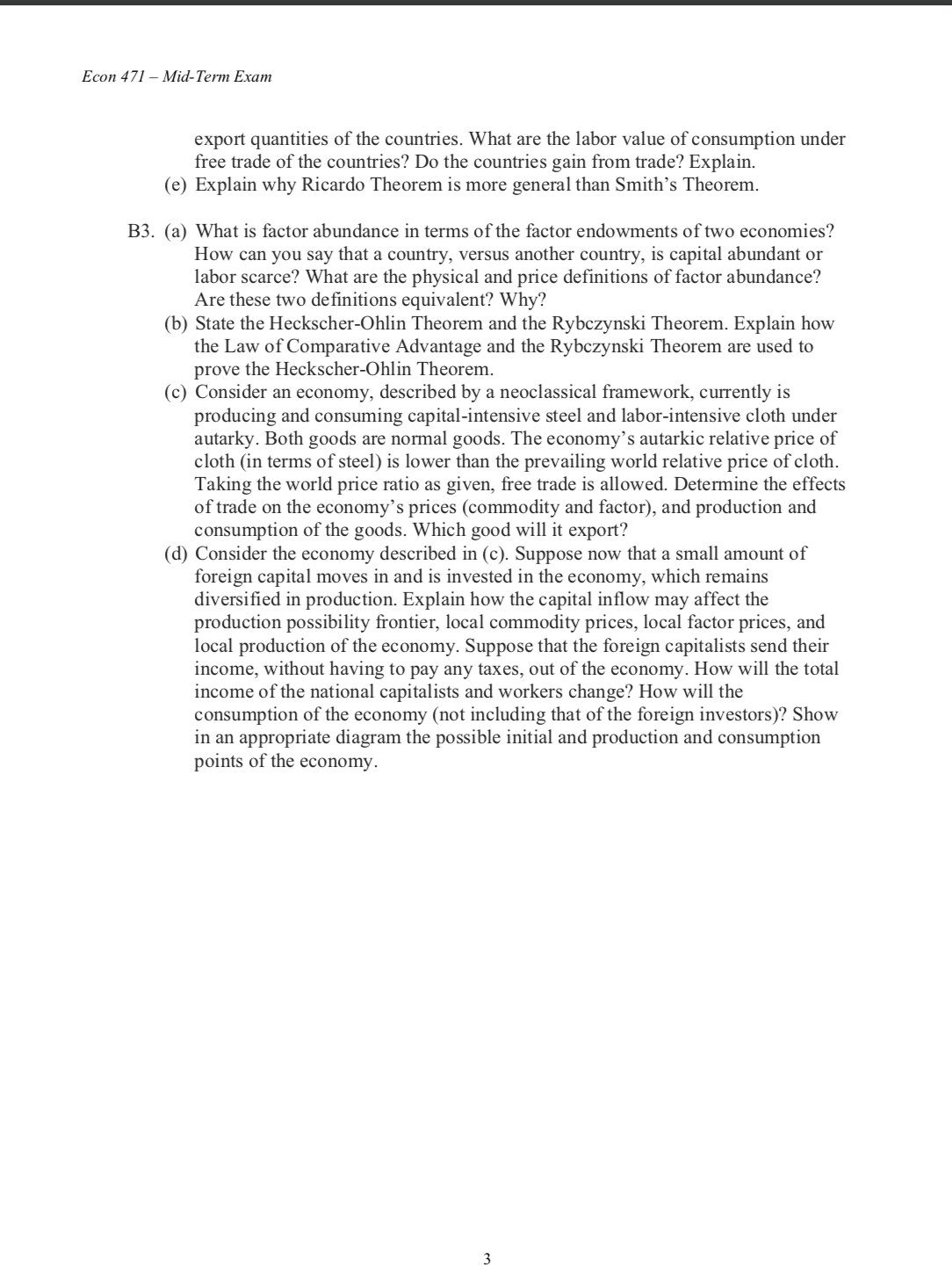
Help! Solve as many as you can! Plz include graphs
ECON 4?] Professor Karyiu Wong International Trade February 10, 2020 Mid-Term Exam Attempt both sections. Write legibly. Draw big diagrams to assist your answers, whenever possible. To earn more points, provide good explanation of your analysis and diagrams. Name any theorems or theories that you apply in your answers. Section A: Answer any FOUR (4) questions in this section. (Each question carries 13 points.) If you answer all questions, only the first four answered will be graded. A]. State the Law of Comparative Advantage in the neoclassical framework. Using simple diagrams, explain why it is true. Do the sizes of the trading economies matter? A2. Explain why in the neoclassical theory the offer curve ofa county (a) passes through the origin; (b) is in the rst and third quadrants only if there is no international transfer or no international factor movement; (c) bends backward. How is the elasticity of a country's import demand related to the slope of its offer curve (whether it bends backward)? A3. Explain how the mercantilists define the wealth of a nation. According to these people, how can a nation become richer and what should the government do to help the nation accumulate wealth? It was argued that their argument could discourage trade among nations. Why? Recently, the US Congress passed the Gephardt Amendment, which some people called the new mercantilism. Compare the original mercantilism with the American one, highlighting their similarities and differences. A4. Consider the Classical framework of international trade. Explain the following properties of the production possibility frontier of an economy: (a) It is negatively sloped. (b) Its slope is constant and is equal in magnitude to the ratio of the labor coefficients of the sectors. (c) Its slope is equal in magnitude to the autarkic price ratio. The Classical theory does not consider the preferences of economies. Explain why it poses no problem in terms of determining autarkic price ratio, but not in terms of determining world's free-trade price ratio. What did the Classical economists do when trying to use the free-trade price ratio? A5. Consider a competitive rm that uses labor and capital to produce a product using the neoclassical technology. When taking all prices as given, explain the cost- minimizing conditions for labor and capital employment. Show the factor employment conditions in an appropriate diagram. Indicate the amounts of labor and capital employed and the capital-labor ratio to produce a specified quantity of product. Suppose that there is an increase in the rental rate while the wage rate remains unchanged. Show how the factor employment and the capital-labor ratio may change, assuming that the output level is kept constant. Show the change in the capital-labor ratio in your diagram, and present an intuition of the result. Econ 47! Mid-Tenn Exam Section B. Answer any TWO questions in this section. (Each question carries 24 points.) If you answer all questions, only the first two answered will be graded. Bl. Consider a partial equilibrium framework representing the local market of shoes. With perfect competition, the supply of shoes in country H is given by S = 20 + 2p while the demand for shoes is D = 400 p, where p is the market price. (a) Determine the autarkic price and quantity of demandx'supply. Also, determine the consumers' surplus, the producers' surplus, and welfare of the market. Derive the export supply function within the price range in which both demand and supply are positive. (b) Consider another country, F, which produces and consumes the same product, shoes. Its export Supply function is given by E" = 240 + 4p*, where an asterisk is used to denote a variable of country F. Determine the autarkic price in the country. (d) Suppose that free trade with no transport costs is allowed between the countries. Determine the free-trade equilibrium price and trade volume. Which country exports shoes? (e) Compare the autarkic prices in the two cauntries. How are these two prices be used to nd out: (a) which country exports the good; (b) the range of the free- trade price in the world? Can you use the result here to establish a theory that is analogous to the Law of Comparative Advantage? (e) Focus now on country H. In a diagram that shows the local demand and supply, indicate the autarkic price and the free-trade price. Explain, using the diagram, how free trade affects local consumption and production. Determine the new consumers' surplus, producer surplus, and welfare of the market. Can you say whether free trade is good for the country? Can you give an economic intuition of your result in terms of whether free trade is good or bad? 82. Consider a Classical world with two countries labelled A and B, each of which is able to produce two goods, textile and steel. Country A produces textile with a labor coefcient of 2 and steel with a labor coefficient of 4. Country B produces these two goods with labor coefcients of 10 and 5, respectively. Countries A and B are endowed with 2000 units and 5000 units of labor, respectively. Both countries always prefer to consume equal quantities of both goods. (a) Determine the autarkic equilibrium of each of the economies before trade, and derive the autarkic price ratio (relative price of textile in terms of steel), production and consumption quantities. What is the Labor Theory of Value and how would you use the present model to illustrade the theory? (b) Determine the absolute and comparative advantages of the economies. (c) State Adam Smith's Theorem of Absolute Advantage. Explain why this theorem is not applicable in the present case. (d) State David Ricardo's Theorem of Comparative Advantage. Suppose now that free trade is allowed between the economies, with no transport cost. What would each economy produce, according to Ricardo's Theorem? Suppose that the free- trade price ratio is equal to one. Determine the consumption quantities and the Econ 47} Mid Tenn Exam export quantities of the countries. What are the labor value of consumption under free trade of the countries? Do the countries gain from trade? Explain. (e) Explain why Ricardo Theorem is more general than Smith's Theorem. B3. (a) What is factor abundance in terms of the factor endowments of two economies? How can you say that a country, versus another country, is capital abundant or labor scarce? What are the physical and price definitions of factor abundance? Are these two denitions equivalent? Why? (b) State the Heckscher-Ohlin Theorem and the Rybczynski Theorem. Explain how the Law of Comparative Advantage and the Rybczynski Theorem are used to prove the Heckscher-Ohlin Theorem. (c) Consider an economy, described by a neoclassical framework, currently is producing and consuming capital-intensive steel and labor-intensive cloth under autarky. Both goods are normal goods. The economy's autarkic relative price of cloth (in terms of steel) is lower than the prevailing world relative price of cloth. Taking the world price ratio as given, 'ee trade is allowed. Determine the effects of trade on the economy's prices (commodity and factor), and production and consumption of the goods. Which good will it export? (d) Consider the economy described in (c). Suppose now that a small amount of foreign capital moves in and is invested in the economy, which remains diversied in production. Explain how the capital inow may affect the production possibility 'ontier, local commodity prices, local factor prices, and local production of the economy. Suppose that the foreign capitalists send their income, without having to pay any taxes, out of the economy. How will the total income of the national capitalists and workers change? How will the consumption of the economy (not including that of the foreign investors)? Show in an appropriate diagram the possible initial and production and consumption points of the economy


